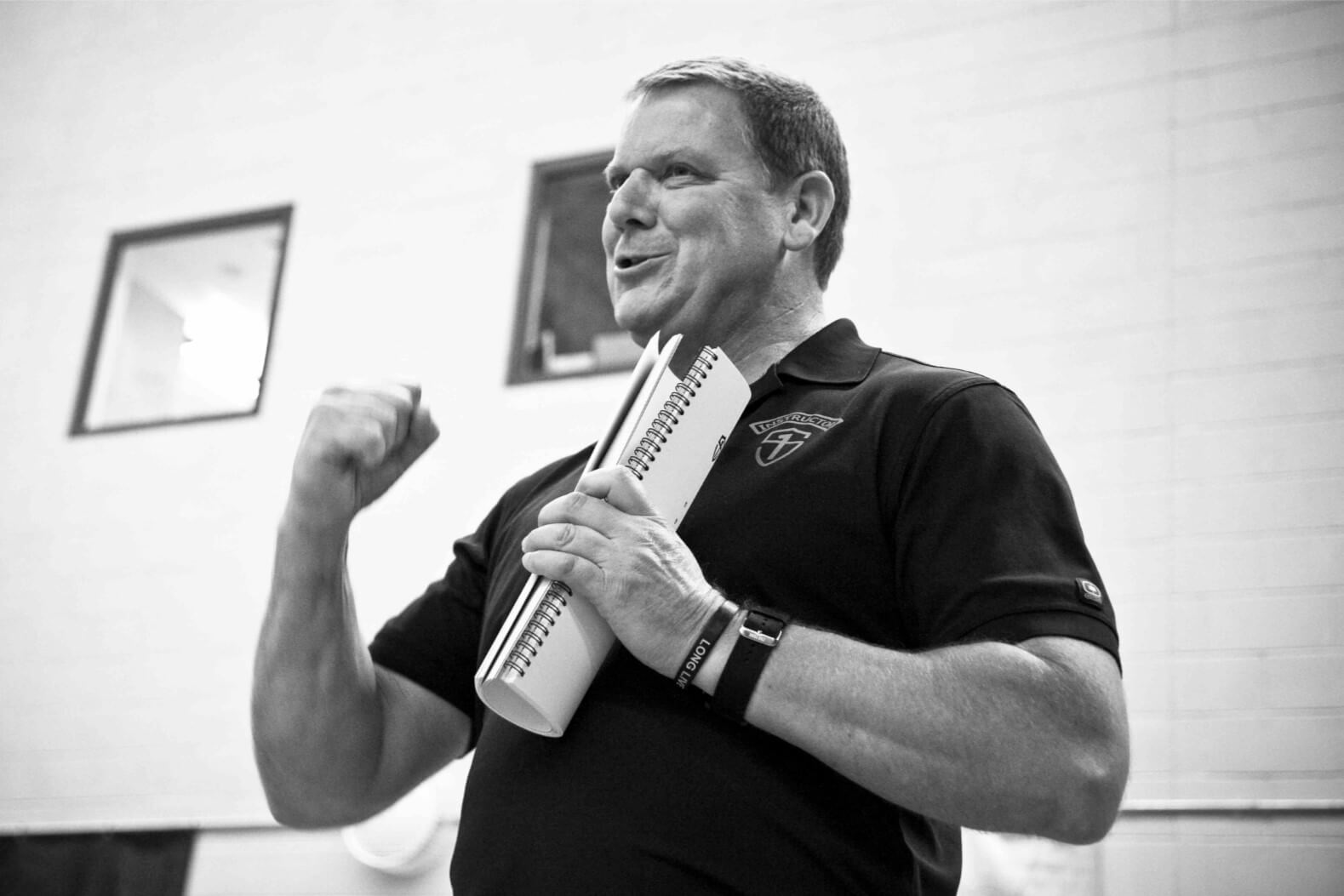Bulging Disc: How to Heal Low Back Pain Naturally & Make a Comeback
When it comes to understanding bulging disc, herniated disc, and other disc injuries that cause back pain, there are some nuances that’ll make it easier for you to heal naturally and make a comeback.
This is Dr. Antonio with Live Loud Chiropractic & Coaching in Lafayette, Colorado. Today, we’re going to cover exactly what bulging discs and herniated discs are and how they cause back pain. Most importantly, we’re going to cover how you can protect yourself from disc injury and what you can do about it if you’re already in pain from a bulging or herniated disc. If you have back pain or you’ve been told you have a disc injury, this blog will be especially useful for you.
PLAY VIDEO ⬇︎
What Are Discs and Vertebral Bodies?
When we’re talking about bulging or herniated disc, it’s not a black or white issue. So first you need to understand certain functions, how certain body parts move and operate, so you better understand your injury. The best way you can do that is by having a proper one-on-one evaluation, but this blog is going to help you immensely in the meantime.
To begin, the disc is what resides in between two vertebral bodies. The vertebral bodies form a column. The spinal cord goes down the middle of that column. It’s protected on the backside by the spinous processes, which is the spine that you can actually feel on your back. And then on the front side are those vertebral bodies. And those vertebral bodies stack up really nice like a column. And that column is what gives structural support to your spine. So when looking at the vertebral bodies, the discs are in the middle of them.
You also have nerve roots that come out from between two vertebral bodies. The nerve roots are what go out to your body, to your trunk, your digestive system, your extremities, so on and so forth to every inch of your body. They direct motor function, carrying signals going out that tell your body to do certain things. They also bring in information to the spinal cord and up to the brain.
You can think of the disc in between as the shock absorbers or the compression component of the spine, as it sits in between those two vertebral bodies. Now, it’s a very strong structure, but it can heal just like any other soft tissue. This foundational information will help you understand how to fix back pain from a disc bulge or herniation.
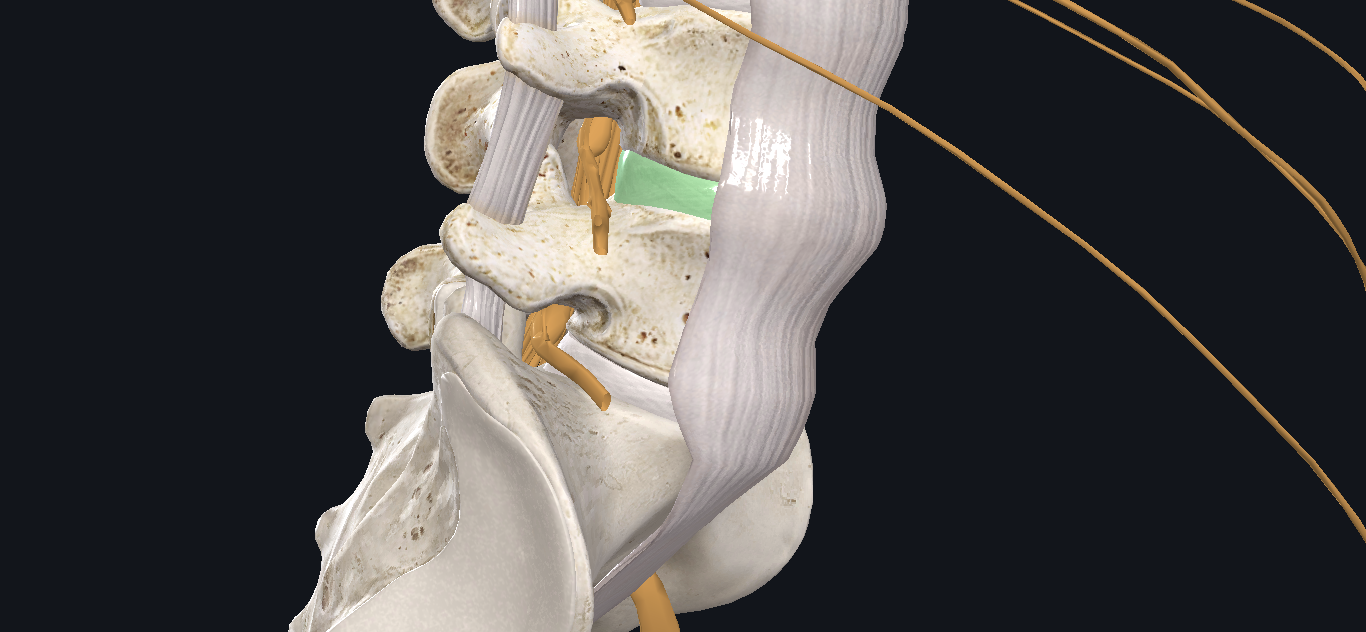
What Are Intervertebral Discs Made Up Of?
To better understand how a bulging disc happens, it’s important to know how the disc is made up. I want you to think of a tree trunk. If you look at an old tree trunk, you can see the rings, and the rings give you an indication of how old the tree is. But in the case of discs, the rings are called the annulus.
In a disc, looking from the top down, you’re going to have all these layers of rings that go from the inside and get bigger and bigger and bigger as they go around the outside. From the sides, you can imagine those rings lining up. But then the rings will also interchange and be at different angles going across each other.
So it creates this network or matrix of these annular rings that come together and can withstand a lot of great compressions. It also helps deflect twisting and rotational forces known as distraction forces. So any sort of force that goes into the disk is absorbed by this network and fiber of webs that pulls and compresses to make it very strong.
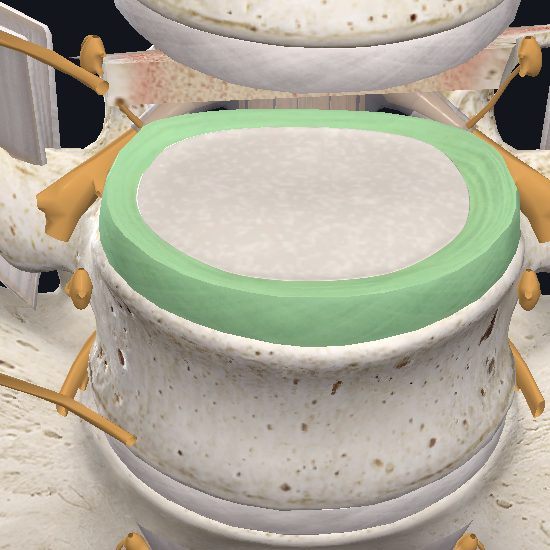
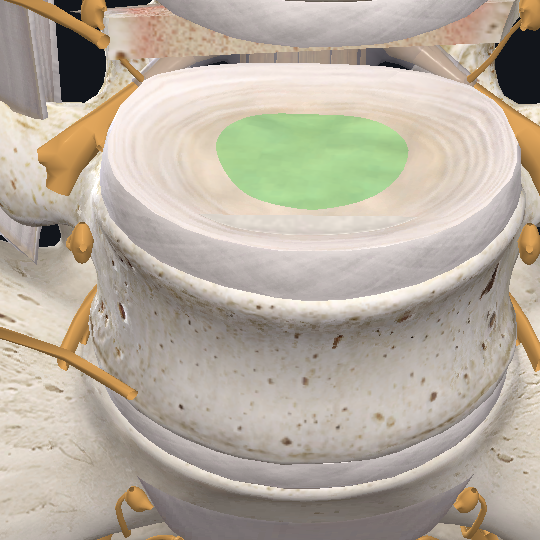
How Do Repetitive Movements Cause Annular Tears?
Now what happens in our day-to-day life is that you tend to do what we call repetitive movements or repetitive behaviors. So, for instance, if you work at a desk, you’re doing a lot of the same positions or movements. If you’re doing any sort of weightlifting or CrossFit or HIIT or even just working out in general, you commonly are doing the exact same motions over and over.
And if a formed technique or another number of factors that can happen begin to build up, then that same repetitive movement pattern wears on those annular rings. And you can get what’s called an annular tear. That’s the beginning of what leads to disc bulges and disc herniations.
Now, depending on the extent of the annular tear, you might not have a true bulge or herniation. You might just have symptoms from the annular tear, depending on where it’s located on the disc. There are three different regions of the disc:
- Middle
- Outer: The outer third of the disc where the actual pain fibers are
- Inner Nucleus: Fluid-filled center
If you have an annular tear without a bulge and you have pain, we do know that that annular tear is probably progressing or migrating towards that outer level.
How Does a Disc Bulge or Herniation Happen?
When talking about how disc bulge or herniation happens, force and pressure are important. Think of the nucleus of the disc as a jelly-filled donut. As you move, that nucleus is going to shift and migrate depending on where the forces are. It’s like a waterbed. If you push on one side of a waterbed, where does the pressure inside the waterbed go? It goes away from you.
That’s really important when we’re looking at disc injuries, herniations, and bulges because we want to know where the force is coming from and where the pressure is going. If you have an annular tear on the outside of the disc, for example, straight compressive forces might be fine.
But we do know from research that the compressive forces within the disc are higher when you’re sitting. And that pressure increases depending on how you’re sitting. As you start to flex forward, for example, the pressure pushes backwards. If you have an annular tear impacted by repeated compression, you’re going to start to see that disk swell into and push through that tear, creating a bulge or bubble on the backside of that disc.

How Does a Disc Bulge Cause a Pinched Nerve?
The bulging disc can actually push back into the spinal column. And depending on how that bulge pushes out, it might be bulging enough to where it puts pressure on a nerve root.
This is where you might get symptoms of sciatica down your leg. You might be feeling numbness or tingling. You might have a little bit of motor weakness or motor loss. Those would all be signs of a true pinched nerve. Oftentimes, when people get nervy pain, they refer to it as a pinched nerve, which may or may not be the case. But this would be an actual pinched nerve.
When your body starts to realize you’re getting this bulge, it’s going to activate the immune system in response to injury. This is going to bring a lot of localized inflammation to help clean up any debris left as a result of the injury, and you’re going to get more localized swelling. That swelling might put additional pressure on that nerve root.
So the pinched nerve might be the byproduct of the swelling in response to the injury, or it could be the disc bulge itself. All are important considerations when dealing with and rehabbing the injury.
Best Movements for Bulging Disc
There are certain movements that help with a bulging disc. To start, it can sometimes be helpful to use a steroid pack to reduce that localized inflammation. This provides you a lot of symptom relief and opens up a window of opportunity for you to do rehab care and movements. This supplements the treatment plan if you’re having a little bit of trouble gaining traction in your recovery.

McKenzie Exercises and Extension Based Movements
One of the best exercises for bulging disc is called the McKenzie extension. If you have a bulge putting pressure on the front side, for example, will push the bulge backwards. With the McKenzie or Extension based movements, you put pressure on the backside of the disc by going through an extension movement. This will actually put pressure into the back of the disk, helping to reduce that bulge or herniation as it migrates forward. This is why we use a lot of hip drops in our office.
Mindful Movements for Bulging Disc
The other thing you need to consider is how you’re moving throughout the day. Let’s say, for instance, you’re unloading the dishwasher. If you’re not hinging through your hip joint, you might add more flexion in your spine and put more pressure and bulging in that disc.
If you’re being super-mindful about how you’re moving, but then do something a little more careless by flexing your spine forward, it’s like having a cut on your knuckle that you’re trying to heal but then grab something so that scab cracks because it’s right at that flex point. And so it makes it very hard to heal that injury when it keeps moving.
This might be a time when you need to put a splint on your finger to not allow it to move so that scab can heal. The same holds true for this disc bulge or herniation. That annular tear can take a little bit longer to heal due to the nature of the blood flow and nutrient supply that it gets, but given time and careful movement, it can heal like other soft tissue injuries.
What commonly happens, though, when most people go through lower back injuries, disc herniations, and bulges is that they’re not focused on the preventative side other than just rest and don’t do anything. They might do some exercises, but they’re really just hoping it will heal with rest. What most people don’t realize is that the positions or motions they’re doing on a daily basis, activities of daily living such as unloading the dishwasher, picking up a bag of dog food, leaning over to wash your face or brush your teeth, are all opportunities in which you can help the healing process or hurt the healing process by scratching that scab that’s trying to heal.
Hip Hinging for Bulging or Herniated Disc
Properly hinging at the hip instead of flexing the spine is one of the best preventative movements for bulging or herniated discs. Your hip joint is a big ball. It’s a big greasy ball and socket joint. It’s really good at providing movement.
The spine, on the other hand, can move and is really good at flexing, but it depends on the load and the context of the task at hand. When you’re picking up something heavy or bending forward, you need to hinge better through the hip to reduce the load on the disk. This way the spine isn’t flexing and bending all that much. Instead, there’s a pivoting around the ball and socket of the hip, allowing the back to remain straight.
Hip hinging is a prime opportunity for you to keep doing all the things that you need to do, especially if you’re a parent, have a very active lifestyle, or just want to continue the activities you enjoy such as gardening. This movement allows you to stay active without continuing to irritate the disc injury and disc you’re trying to protect.
Prevention Goes a Long Way for Bulging Discs
These preventative measures are one of the most critical factors when trying to get over disc bulges and herniations. The way you develop a condition is commonly how you get out of it. So if you have poor movement mechanics from exercising or lifting at work, for example, then you need to be mindful about those things so that you can let the disc heal while also staying active. You also need to know these mindful preventative movements are what you need to work on going forward so you don’t reinjure the disc.
Again, disc bulges and herniations can and do heal. They often just need a little bit more time and effort. Most don’t know to make the necessary changes to their movement patterns. And they just keep irritating the disc. That’s why healing can get super frustrating. You think…Oh, it’s been a couple months and I’m not seeing any progress or things are getting worse.
If this is you, take a step back. You’re just forgetting that you have to be mindful of those movements patterns. Almost everyone sees some disc bulging or herniation from time to time. It can’t be avoided completely. But when you do get that little bit of pain, it’s an indication that the movements or activities you’re doing are causing too much disc loading and pressure.
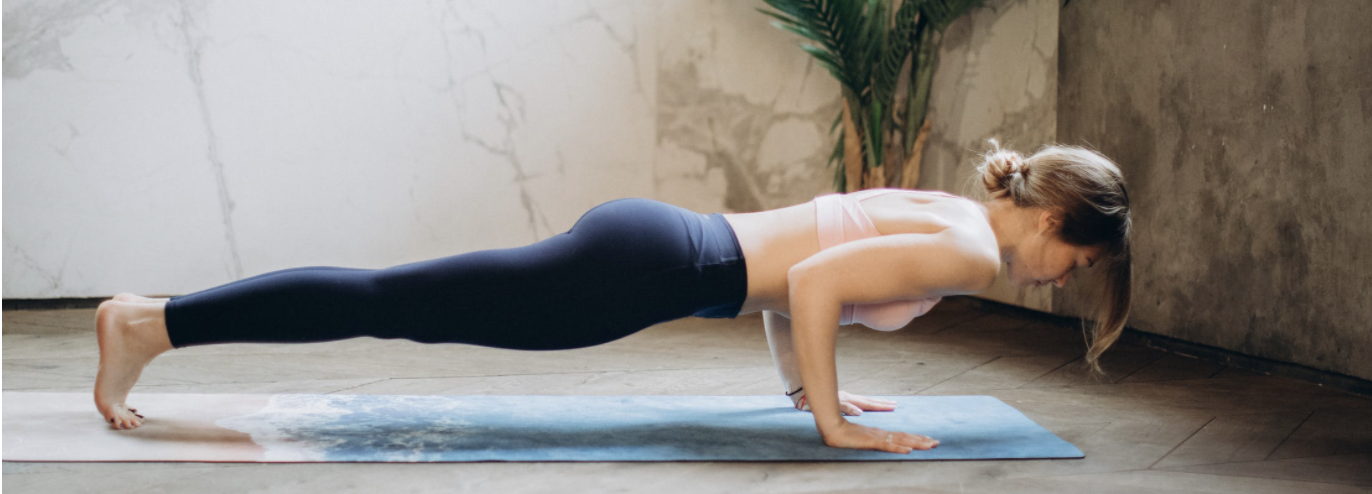
Muscle Guarding With Bulging Discs
Now the last thing you’ll want to consider is, oftentimes, a lot of the pain you might be experiencing is the muscle guarding intention that comes as a byproduct.
It is very rare that you will actually strain a big, thick hearty muscle such as the QL. Yes, it’s possible when doing a lot of the movements that trigger or exacerbate lower back pain. But what we often at Live Loud Chiropractic headquarters in Lafayette is that pain is a byproduct in muscle guarding the nerves or the discs.
When you start doing a lot of activities or repetitive movement patterns that constantly irritate those structures, your body is going to say…This does not feel good. I need to lock it up and protect it so that things don’t get worse. And then you get a lot of lower back tension or tightness or spasms or guarding.
Imagine if I asked you to hold your bicep and squeeze it really tight. How would that bicep feel after a couple minutes, hours, days, or even a couple weeks? It’s going to start burning. It’s going to hurt because it’s constantly in the contracted state. When muscles are contracted, they also squeeze arteries and vessels that go through them and supply them with nutrients and oxygen. So the muscle starts to burn even more because it’s in a hypoxic state, and it’s not getting the actual nutrients and oxygen it needs.
The Feed-Forward Mechanism in Naturally Healing Disc Bulging
Now the last thing you’ll want to consider is, oftentimes, a lot of the pain you might be experiencing is the muscle guarding intention that comes as a byproduct.
It is very rare that you will actually strain a big, thick hearty muscle such as the QL. Yes, it’s possible when doing a lot of the movements that trigger or exacerbate lower back pain. But what we often at Live Loud Chiropractic headquarters in Lafayette is that pain is a byproduct in muscle guarding the nerves or the discs.
When you start doing a lot of activities or repetitive movement patterns that constantly irritate those structures, your body is going to say…This does not feel good. I need to lock it up and protect it so that things don’t get worse. And then you get a lot of lower back tension or tightness or spasms or guarding.
It’s important for you to find opportunities that allow the muscles that are guarding and protecting to calm down and relax in order to help the healing process. The more those muscles calm down and relax, the more you’re able to move. And the more you’re able to move, the more blood flow can get in to heal the area.
This will also allow you to realize that certain movements are actually feeling good.This is called a “feed-forward mechanism” or a “snowballing effect.” If you can get rolling in the right direction and gain some momentum, then, commonly, you’re going to keep that momentum going forward in a good way.
The Negative Feedback Loop In Naturally Healing Disc Bulging
The same is also true, though, when you start irritating it. If you’re not being conscious about the movements that irritated it in the first place or that cause more pressure on the disk, then you start having a negative feedback loop. The more pain you feel, the more pain you’re going to experience. And then the more pain you’re in, the more you’re going to become sensitized. Until you get to the point that any little movement or anything out of the norm is going to set you off and trigger more pain.
This is very common for a lot of chronic pain individuals. They just see this bouncing from…I’m good for a little bit, but then I get really bad. And then I feel a little better because I don’t do anything. And then I get really bad. They’re constantly in this flip-flop mode of too hot, too cold, too hot, too cold. In these cases, we really need to dive deep to discover what exact movements and activities irritate it, which it going to be different for everybody.
Making a Comeback after Disc Bulging, Herniation, and Injury
The biggest takeaway is that you need to find opportunities that allow you to move and keep moving. You need to look at the ways you can work on muscle tension and how you can move better. You should look at the ways you’re doing your exercise classes, your training, or working out at the gym. Those repetitive movements are all really important pieces of the puzzle. But there is not a one-size-fits-all approach. It has to be tailored for your body.
We do see a theme, though, with disc herniation and bulges. For many people, it’s that bending forward and flexing forward that tends to trigger them the most. So we have a couple of starting points that work really well.
First, if you have nerve pain or signals or symptoms, don’t just assume you need drugs or surgery. Movements and decompression are also very, very valuable. You just need to know the right exercises to do, and McKenzie extensions and hip hinges are a great place to start.
Next, if you are suffering from disc injury or you’ve been told you have a disc herniation bulge, do not write this off as a death sentence. There are a lot of things you can do. Your disc can heal itself. And even if it doesn’t do that completely, there are additional exercises to continue to strengthen your core and your hips. These can help stabilize and make your back stronger and more robust, which might have been the reason a disc injury happened in the first place.
Finally, if you have experienced disc injury, you know how tough it is. I hope this information helps boost your confidence while recovering from injury as well as preventing re-injury if you tend to have recurrent back pain episodes. And if you know of someone who’s dealing with a disc injury, please share this information with them.
Conclusion
Unfortunately, many of these things are not being taught by medical providers, orthopedics, or physiatrists. Even physical therapists are sweeping some of this under the rug, asserting that these basic movement changes don’t work. But they do. Now you understand how the discs work and can ask the right questions to figure out the right path for you to heal and get on with the adventurous life you are made for.
We’d love to hear your bulging disc or disc herniation questions and experiences. Comment below to tell us what has or hasn’t worked for your disc injuries.


